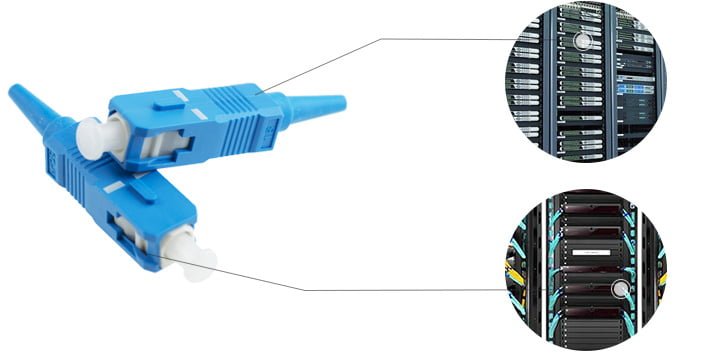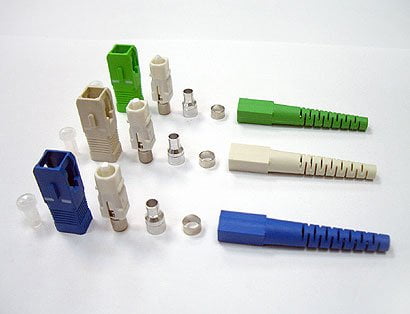An SC connector is a type of fiber optic connector that is widely used in telecommunications and data communications networks. SC stands for Subscriber Connector or Square Connector, and it was developed in the 1980s by NTT, a Japanese telecommunications company.






The SC connector has a square-shaped body and a push-pull mechanism for easy insertion and removal. It uses a ceramic ferrule to align and hold the fibers in place, which provides high precision and low signal loss. The SC connector is designed to be highly reliable and is commonly used in single-mode fiber optic applications.
One of the advantages of the SC connector is that it is relatively easy to terminate and install, compared to other types of connectors such as the ST or FC. The push-pull mechanism allows for quick and easy installation, and the square shape of the connector body makes it easy to identify and differentiate from other connectors.
The SC connector is commonly used in telecommunications and data communications networks, particularly in single-mode fiber optic applications where high precision and low signal loss are critical. It is also used in cable TV and broadband networks, as well as in some industrial and military applications.
The SC connector is a fiber optic connector that is commonly used in telecommunications and networking applications. It is a type of push-pull connector that uses a ferrule to align and connect the fibers.
- SC Connector Body: The body of the SC connector is typically made of plastic or metal and houses the ferrule and the connector housing.
- SC Connector Ferrule: The ferrule is a small ceramic or metal cylinder that holds the fiber in place and aligns it with the receiving fiber. It is the most critical part of the connector and is responsible for ensuring a low-loss connection.
- SC Connector Housing: The connector housing is the outer shell of the connector and provides protection for the ferrule and the fiber. It also has a latch mechanism that allows for easy insertion and removal of the connector.
- SC Connector Boot: The boot is a rubber or plastic cover that fits over the connector housing and provides strain relief for the fiber. It also helps to protect the connector from dust and other contaminants.
Here are some additional details about the SC connector:
- Connector body: The SC connector has a square-shaped body that is approximately 10 millimeters wide. The body is usually made of plastic or metal and is designed to be easy to grip and manipulate during installation.
- Ferrule: The ferrule is the part of the connector that holds the fiber in place. The SC connector uses a ceramic ferrule that is precision-machined to ensure accurate alignment and low signal loss.
- Polishing: The end-face of the ferrule is polished to a high degree of smoothness to ensure maximum light transmission and minimize signal loss. The polishing process is critical for achieving optimal performance and reliability.
- Push-pull mechanism: The SC connector uses a push-pull mechanism for easy insertion and removal. The connector has a spring-loaded mechanism that allows it to snap into place when inserted, and can be easily removed by pulling on the release tab.
- Single-mode applications: The SC connector is commonly used in single-mode fiber optic applications, where high precision and low signal loss are critical. It is particularly well-suited for long-haul telecommunications and data communications networks.
- Multimode applications: While the SC connector is primarily designed for use with single-mode fiber optic cables, it can also be used with multimode fiber optic cables. However, its performance in multimode applications may not be as good as other connectors that are specifically designed for multimode fibers.
- SC APC vs SC UPC: The SC connector is available in two different polishing styles – angled physical contact (APC) and ultra physical contact (UPC). The APC configuration has a slight angle on the end-face of the ferrule, which reduces reflectance and enhances performance in single-mode applications. The UPC configuration has a flat end-face and is used primarily in multimode applications.
Here are some more details about the SC connector:
- Compatibility: The SC connector is compatible with a wide range of fiber optic cables, including both single-mode and multimode fibers. It is also compatible with different types of equipment such as transceivers, switches, and routers.
- Durability: The SC connector is known for its durability and resistance to wear and tear. It is designed to withstand repeated insertion and removal cycles without any degradation in performance.
- Low insertion loss: The SC connector has low insertion loss, which means that it is able to transmit optical signals with minimal attenuation. This makes it ideal for high-speed, high-bandwidth applications such as telecommunications and data center networks.
- High return loss: The SC connector also has high return loss, which means that it is able to reflect a high percentage of light back towards the source. This helps to minimize signal loss and ensure reliable data transmission.
- Ease of use: The push-pull mechanism of the SC connector makes it easy to install and remove, even in tight spaces. The square shape of the connector body also makes it easy to distinguish from other connectors, which helps to reduce installation errors.
- Dust caps: The SC connector is typically supplied with a dust cap that helps to protect the ferrule from contamination by dust or other particles. The dust cap should always be kept in place when the connector is not in use to ensure maximum performance and reliability.
- Applications: The SC connector is used in a wide range of applications, including telecommunications, data center networks, cable TV, and broadband networks. It is also used in some industrial and military applications where high reliability and performance are essential.
In summary, the SC connector is a versatile and reliable fiber optic connector that is widely used in telecommunications and data communications networks. Its low insertion loss, high return loss, and ease of use make it ideal for high-speed, high-bandwidth applications, while its durability and resistance to wear and tear ensure reliable performance over the long term. The SC connector is a widely used type of fiber optic connector that provides high precision and low signal loss. It is commonly used in single-mode fiber optic applications and is known for its reliability and ease of installation. the SC connector is a versatile and widely used fiber optic connector that provides high precision and low signal loss. Its push-pull mechanism and square-shaped body make it easy to install and manipulate, while its ceramic ferrule and precise polishing ensure maximum performance and reliability in single-mode applications.

